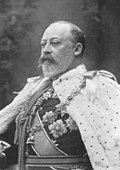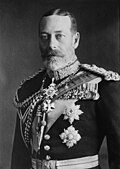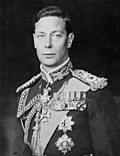| Portrait | Regnal name
(Birth–Death)
Royal dynasty | Reign over Australia | Full name | Consort |
|---|
| Start | End |
|---|
| Royal Style | Major Events |
|---|
 | George III
(1738–1820)
House of Hanover | 20 January 1788 | 29 January 1820 | George William Frederick | Charlotte of Mecklenburg-Strelitz |
| 1788-1801: George the Third, by the Grace of God, King of Great Britain, France [f] , and Ireland, Defender of the Faith, &c. | 1788: Beginning of the British colonisation of Australia 1808-1810: Rum Rebellion 1811-1820: The Regency |
| 1801-1820: George the Third, by the Grace of God, of the United Kingdom of Great Britain and Ireland, King, Defender of the Faith |
 | George IV
(1762–1830)
House of Hanover | 29 January 1820 | 26 June 1830 | George Augustus Frederick | Caroline of Brunswick |
| George the Fourth, by the Grace of God, of the United Kingdom of Great Britain and Ireland, King, Defender of the Faith | 1824: Foundation of the NSW Legislative Council 1825: Establishment of Van Diemen's Land (later Tasmania) 1829: Establishment of the Swan River Colony (later Western Australia) |
 | William IV
(1765–1837)
House of Hanover | 26 June 1830 | 20 June 1837 | William Henry | Adelaide of Saxe-Meiningen |
| William the Fourth, by the Grace of God, of the United Kingdom of Great Britain and Ireland, King, Defender of the Faith | 1835: Batman's treaty with Wurundjeri elders declared void 1836: Establishment of South Australia |
 | Victoria
(1819–1901)
House of Hanover | 20 June 1837 | 22 January 1901 | Alexandrina Victoria | Albert of Saxe-Coburg and Gotha |
| 1837-1876: Victoria, by the Grace of God, of the United Kingdom of Great Britain and Ireland, Queen, Defender of the Faith | 1843: First parliamentary election 1851: Establishment of Victoria 1854: Eureka Stockade 1855: Responsible government in New South Wales, Victoria, and Tasmania 1856: Responsible government in South Australia 1859: Establishment of Queensland 1868: End of penal transportation 1867-1868: First royal visit to Australia (Prince Alfred) 1881: First visit by a future Sovereign (George V) 1890: Responsible government in Western Australia 1901: Federation of Australia |
| 1876-1901: Victoria, by the Grace of God, of the United Kingdom of Great Britain and Ireland Queen, Defender of the Faith, Empress of India |
 | Edward VII
(1841–1910)
House of Saxe-Coburg and Gotha | 22 January 1901 | 6 May 1910 | Albert Edward | Alexandra of Denmark |
| 1901: Edward the Seventh, by the Grace of God, of the United Kingdom of Great Britain and Ireland King, Defender of the Faith, Emperor of India | 1907: Australia referred to as a dominion for the first time |
| 1901-1910: Edward the Seventh, by the Grace of God, of the United Kingdom of Great Britain and Ireland and of the British Dominions beyond the Seas King, Defender of the Faith, Emperor of India |
 | George V
(1865–1936)
House of Saxe-Coburg and Gotha (until 1917)
House of Windsor (after 1917) | 6 May 1910 | 20 January 1936 | George Frederick Ernest Albert | Mary of Teck |
| 1910-1927: George the Fifth, by the Grace of God, of the United Kingdom of Great Britain and Ireland and of the British Dominions beyond the Seas King, Defender of the Faith, Emperor of India | 1919: Australia signs the Treaty of Versailles 1920: Visit by future Edward VIII 1926: Visit by future George VI 1926: Balfour Declaration 1931: Statute of Westminster 1931: First Australian-born governor-general (Issac Issacs) 1932: Dismissal of premier Lang |
| 1927-1936: George the Fifth, by the Grace of God, of Great Britain, Ireland, and the British Dominions beyond the Seas King, Defender of the Faith, Emperor of India |
 | Edward VIII
(1894–1972)
House of Windsor | 20 January 1936 | 11 December 1936 | Edward Albert Christian George Andrew Patrick David | None |
| Edward the Eighth, by the Grace of God, of Great Britain, Ireland, and the British Dominions beyond the Seas King, Defender of the Faith, Emperor of India | 1936: Edward VIII abdication crisis |
 | George VI
(1895–1952)
House of Windsor | 11 December 1936 | 6 February 1952 | Albert Frederick Arthur George | Elizabeth Bowes-Lyon |
| 1936-1948: George the Sixth, by the Grace of God, of Great Britain, Ireland, and the British Dominions beyond the Seas King, Defender of the Faith, Emperor of India | c.1930s-1940s: Emergence of a separate Crown 1942: Statute of Westminster Adoption Act passed 1945-1947: Governor-generalship of Prince Henry 1946: First Australian-born state governor (Sir John Northcott) |
| 1948-1952: George the Sixth, by the Grace of God, of Great Britain, Ireland, and the British Dominions beyond the Seas King, Defender of the Faith |
 | Elizabeth II
(1926–2022)
House of Windsor | 6 February 1952 | 8 September 2022 | Elizabeth Alexandra Mary | Philip Mountbatten |
| 1952-1953: Elizabeth the Second, by the Grace of God, of Great Britain, Ireland, and the British Dominions beyond the Seas Queen, Defender of the Faith | 1953:Royal Style and Titles Act1953 passed 1954: First visit by a reigning Sovereign 1965: Last British governor-general leaves office (William Sidney) 1966: Future Charles III attends the Geelong Grammar School in Victoria for one term 1973:Royal Style and Titles Act 1973 passed 1975: Dismissal of Prime Minister Whitlam 1983: Last British state governor leaves office (Richard Trowbridge) 1986: Australia Acts passed 1992: Pre-colonial Indigenous land rights recognised in the Mabo case 1999: United Kingdom legally found to be a "foreign power" 1999: Republic referendum defeated |
| 1953-1973 (Commonwealth): Elizabeth the Second, by the Grace of God, of the United Kingdom, Australia, and her other Realms and Territories Queen, Head of the Commonwealth, Defender of the Faith | 1953-1986 (State): Elizabeth the Second, by the Grace of God, of the United Kingdom of Great Britain and Northern Ireland and of her other Realms and Territories Queen, Head of the Commonwealth, Defender of the Faith |
| 1973-2022 (Commonwealth): Elizabeth the Second, by the Grace of God, Queen of Australia and her other Realms and Territories, Head of the Commonwealth |
| 1986-2022: Elizabeth the Second, by the Grace of God, Queen of Australia and her other Realms and Territories, Head of the Commonwealth |
 | Charles III
(born 1948)
House of Windsor | 8 September 2022 | Present | Charles Philip Arthur George | Camilla Shand |
| King [b] Charles the Third, by the Grace of God, King of Australia and his other Realms and Territories, Head of the Commonwealth | 2024: First visit by a reigning King |




































